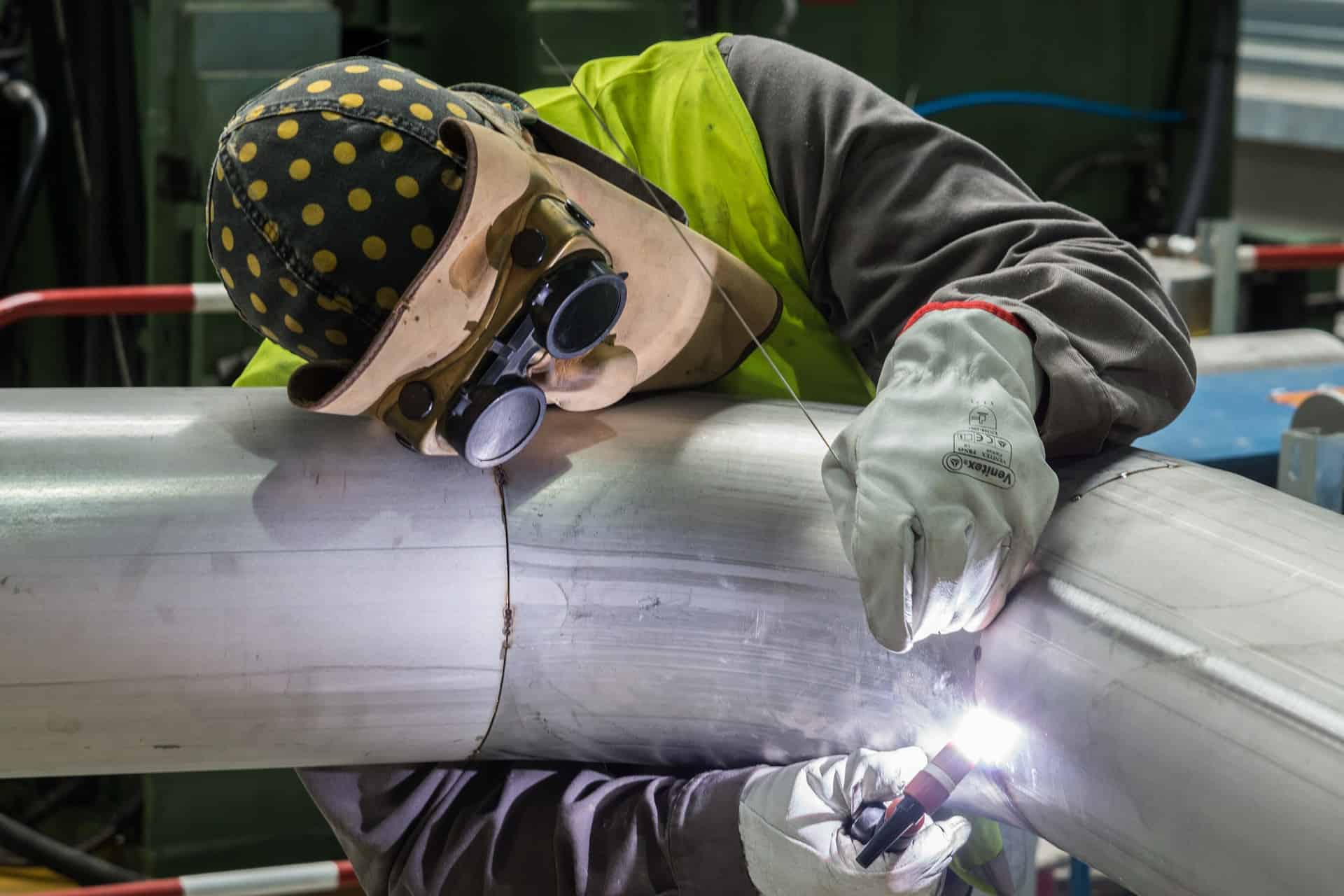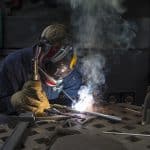As an Amazon Associate I earn from qualifying purchases through links from this site. See the disclosure page for details.

I’m sitting right here in my workshop in front of a stainless steel repair job, wondering how to weld stainless steel the right way. So I did a little recherche on the web on stainless steel welding and look what I found out.
- There are five basic types of stainless steels, which are Austenitic, Martensitic, Ferritic, Duplex and Precipitation Hardening (PH) stainless steel.
- You need to choose the right process parameters and find compatible filler material for your base materials.
- Make sure to do preparation works with stainless steel tools only. Clamp your workpiece and apply less energy compared to carbon steels to avoid warping.
- There are types of stainless steels that require preheating or slow cooling.
Now let’s go into the details.
What is welding?
Welding is a joining process where you permanently join two or more workpieces made of metal. This is done by applying high heat melt the metal locally. Welding can be done with or without additional filler material.
Because each metal has its own specific material properties, welding stainless steel is a little bit different from welding standard mild steel.
back to menu ↑What different types of stainless steels can you weld?
In general, there are five different types of stainless steels you can weld.
Because stainless steel is up to five times more expensive than standard carbon steel, you should take care to process this corrosion-resistant material correctly.
Each stainless steel has its individual characteristics, which I found in my research and listed it below:
Welding austenitic stainless steel
Austenitic stainless steel, or so-called 300 series, is the most common type of stainless steel used in workshops for welding. Austenitic stainless steel does not need any preheating but has a maximum interpass temperature of 350 degrees Fahrenheit.
As a general rule of thumb, use the same filler metal as your base metal is. For example, when welding with 316L, you should use 316L filler material.
309 and 310 sheets of stainless steel are primarily used for high-temperature applications above 1400 degrees Fahrenheit.
Welding martensitic stainless steel
Martensitic stainless steel gets very hard and has a high strength. Martensitic stainless steel can be identified by the AISI 400 series. Usually, it contains 11.5% up to 18% chromium and up to 0.15 up to 1.2% carbon
By controlling the preheat temperature and interpass temperatures cracks can be avoided when welding martensitic stainless steels.
Martensitic stainless steel usually has a preheating temperature of 400 to 600 degrees Fahrenheit. During welding, the temperature should not drop below your preheat temperature.
Depending on the carbon content, different preheat and post-treatment conditions are needed:
- Below 0.10% C – usually no preheating or post heat treatment after welding required
- 0.10 – 0.20% C – preheat to 500°F, weld, slow cooldown
- 0.20 – 0.50% C – preheat to 500°F, weld, heat treatment
- Over 0.50% C: – preheat to 500°F, high heat welding, heat treatment
(Source: Nickelinstitute, WELDING OF STAINLESS STEELS AND OTHER JOINING METHODS )
Welding ferritic stainless steel
Ferritic stainless steel is often used in automotive industry, you can also find them in the AISI 400 series. Pure ferritic steel does not require pre-weld or post-weld heat treatments. If you add too much heat, ferritic stainless steel will drastically lose its strength because of grain growth.
Steel sheets that are thinner than 1/4 in do not require preheating. Thicker parts can need pre-heat temperature in the area of 300-450°F. Ferritic stainless steel has a maximum interpass temperature of 300 degrees Fahrenheit. Ferritic stainless steel that contains martensitic structures can require a post heat treatment at 380-1470°F to restore ductility after welding.
It is recommended to choose the same filler material as the base material. Typically 409 or 439 filler material is used to weld ferritic stainless steels.
Welding duplex stainless steel
Preheating duplex stainless steel is usually not required. Duplex stainless steel is a combination of austenitic and ferritic stainless steel. Choosing filler material for duplex stainless steel is more tricky because many duplex stainless base metals are not available for filler materials.
Welding duplex stainless steel is more complicated and requires more preparation work to find the right filler material and process parameters. Contact a professional to assist you here.
Welding precipitation hardening (PH) stainless steel
Welding PH stainless steels from my point of view is a science itself. Thus, you can find more information about welding PH stainless steel right here at TWI global.
Post-and preheat conditions depend highly on the condition of the base material. Detailed investigations need to be made before you start welding to avoid cracks.
back to menu ↑How to prepare the workpiece and yourself?
When you work with stainless steel, make sure you use tools that are made of stainless steel, too. If you use tools that contain ferritic particles or are made of ferritic steel, you will contaminate the stainless steel workpiece. This will lead to ugly corrosion on your stainless steel sheet.
Do not use the same stainless steel brush with carbon steel and with stainless steel.
Make also sure to use a stainless steel vise or c-clamp to attach your workpiece.
Dry the workpiece if there is moisture and preheat if it is not on room-temperature yet.
Prepare yourself with regular welding protection clothing like welding helmet, welding gloves and welding jacket.
How to weld stainless steel?
Like always when welding, you need the right welding machine settings.
So, I was wondering, which type of welding is right for stainless steel at all. In my recherche, I realized, that you can either MIG/TIG or Stick weld stainless steel. Now take a look how to weld stainless steel with each technology.
How to MIG weld stainless steel?
Generally speaking, MIG welding stainless steel is four times faster than TIG welding. Usually, it is done at DCEP (DCRP) direct current polarity.
For austenitic stainless steel use similar parameters as with carbon steel. Because stainless steel has a higher coefficient of thermal expansion that is approximately 50% higher than carbon steel welding it can result in higher distortions. Moreover, stainless steel has lower thermal and electrical conductivity. Try to maintain a consistent tip to workpiece distance to avoid changes in current levels.
Recommended shielding gas for short circuit stainless steel MIG welding is a tri-mix shielding gas. For example, you can use 90%He, 7.5%Ar and 2.5% CO2. (Source: Lincoln Electric)
How to GTAW/TIG weld stainless steel?
When welding stainless steel use DCEN polarity and 2% thoriated tungsten. Use Argon as shielding gas. The diameter of the filler metal should be thinner than the thickness of the base metal. Filler material and base material should be the same. Regulate the power so that the weld puddle diameter is not bigger than the thickness of your base material. To weld stainless steel, you should start at a high pulse rate of at least 100 PPS and end at 500 PPS.
(Source: American Welding Society)
Many people prefer to equip their TIG holder with a “gas lens” which helps to focus the argon gas and improves shielding in the weld area.
How to Stick weld stainless steel?
In SMAW welding there is no shielding gas required but a welding rod that is compatible with stainless steel. To stick weld stainless steel make sure to set amperage low enough so that you get a smooth arc from start to finish. Typically a 309 or 312 stick electrode is being used.
After you are finished welding, make sure to clean up the slag with a brush made of stainless steel.
back to menu ↑Why would you want to weld stainless steel?
As you probably know, stainless steel does not rust and is also 100% recyclable.
Because stainless steel is very durable and has a good look, it is used in a lot of applications. The best example that everybody knows is the kitchen sink made of stainless steel. It is corrosion free, resistant to heat and damage. Moreover, stainless steel surfaces survive aggressive acids and intensive cleaning. This is because of the self-repairing film it has on its surface.
Besides food industry, stainless steel is very popular in piping and petrochemical industry. So either you’d be in one of those industries, or you need to repair or construct something made of stainless steel.
If you have any experiences in how to weld stainless steel, I’d be happy when you share your thoughts with me below.
Image Credits: Pixabay / Martinelle








